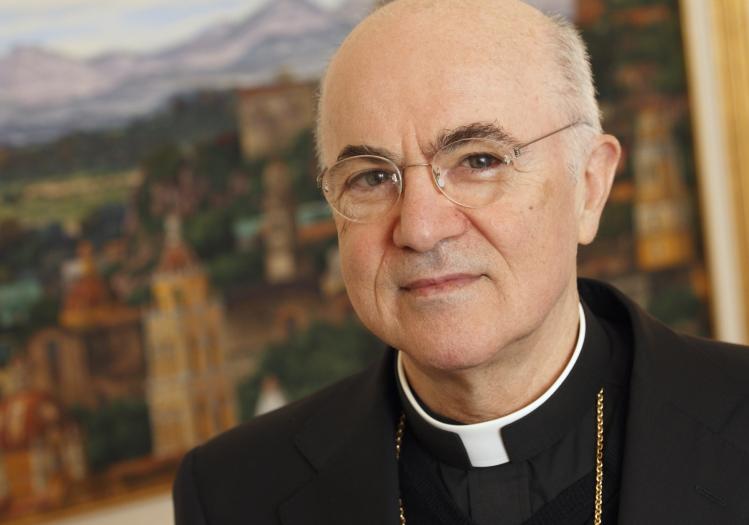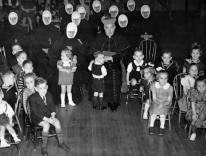
Much of the coverage of the letter from Archbishop Carlo Maria Viganò concerning the cover-up of sexual misconduct allegations against Theodore McCarrick is focusing on Pope Francis’s potential role in it. That’s just the spin Viganò and conservative critics of the pope were hoping for. But in looking more closely at everything that Viganò alleges, Francis’s immediate predecessors don’t fare very well either: he depicts John Paul II as at best oblivious to the facts of the McCarrick case because of health reasons, and Benedict XVI as so ineffectual that the Curia didn’t bother enforcing the restrictions he allegedly placed on the cardinal.
Viganò’s charge against Pope Francis is not that he created the problem but that he failed to clean it up once he knew. Keep in mind, though, that McCarrick’s situation was one strand in a complex web of curial deceit that Francis inherited when he became pope. Many of the same people now seizing on Viganò’s claims against Francis had criticized the pope for being unfair, in their view, to curial officials his predecessors appointed.
Francis told the Curia about its fifteen “diseases” in a pre-Christmas greeting in 2014, a diagnosis that included “spiritual Alzheimer’s disease,” “rivalry and vainglory,” gossip and back-biting, hoarding material goods, and “the disease of persons who insatiably try to accumulate power and to this end are ready to slander, defame and discredit others, even in newspapers and magazines.” The problem with Francis has not been the diagnosis, but following through on a treatment plan.
Back to the news coverage. The news lead—the opening paragraph that becomes the basis for the headline—should look beyond Viganò’s spin to what’s really important about his assertions. The most important news in Viganò’s letter is not so much about any single one of his uncorroborated allegations—claims that may be influenced by his own anger and biases—or his grandiose call for the pope’s resignation. Rather, it’s his assertion of how widespread knowledge of McCarrick’s alleged misdeeds was in the Vatican since at least 2000. Many of those claims will either be documented—or not—in the thick file of Vatican records he referred to.
Here’s how I would have gone about writing the opening of the breaking story. There would be a lot more to add, of course, but hopefully this gives a sense of how much more this situation really involves.
A former papal nuncio to the United States has charged that a broad range of officials at the highest levels of the Catholic Church—including Pope Francis and top aides to his two predecessors—were part of a two-decade cover-up of allegations that Cardinal Theodore McCarrick had sexually harassed and abused seminarians.
Archbishop Carlo Maria Viganò, the papal ambassador in Washington from 2011 to 2016 and a high-ranking Vatican official before that, asserted that Pope Benedict had ordered that McCarrick be barred from active ministry some time in 2009 or 2010. McCarrick, who retired as archbishop of Washington, D.C., in 2006, continued to be highly visible, however. According to Viganò, McCarrick enjoyed a high status in the Vatican even after Viganò told Pope Francis about the sex allegations in June 2013.
In his “testimony,” Viganò says that the Vatican knew of the allegations at least as early as November 22, 2000—which was one day after John Paul II’s appointment of McCarrick as archbishop of Washington was announced. Viganò said he was told that Archbishop Gabriel Montalvo, papal nuncio in the United States at the time, had asked a priest who knew of the allegations to document them in a letter, which Montalvo passed along to Cardinal Angelo Sodano, the Vatican secretary of state.
Nonetheless, the Vatican announced less than two months later that Pope John Paul II had elevated McCarrick to cardinal. Viganò suggested in his letter that Sodano was responsible “when John Paul II was already very ill.” The pontiff, who died in 2005, was ailing in that period but still making overseas trips.
Beyond that, Viganò’s list of cardinals and archbishops who knew about McCarrick’s alleged liaisons with seminarians reads like a page from a Vatican phone directory. He names more than a dozen prelates who he said had direct knowledge and failed to act, including Cardinal Tarcisio Bertone, the Vatican secretary of state from 2006 to 2013.
Viganò’s most scathing criticism is leveled at Pope Francis. “In keeping with the proclaimed principle of zero tolerance, Pope Francis must be the first to set a good example for cardinals and bishops who covered up McCarrick’s abuses and resign along with all of them,” he wrote.
But questions about Viganò’s credibility quickly surfaced after his letter was released on two conservative Catholic websites, in part because of his own history of dealing with abuse allegations. According to a church memo made public through litigation, he ordered bishops from the Archdiocese of St. Paul and Minneapolis in 2014 to end an investigation into allegations against Archbishop John Nienstedt, who resigned the following year. …
Having written four thousand or more news articles in a twenty-three-year career in daily journalism, and having taught that skill to college students for sixteen more years, I can tell you that there is no single approved way to write a complex story like this. There is a lot to consider, and the deadline is ASAP. Here, I left the Vatican politics, an important element of the story, for later in the piece. Maybe questions about Viganò’s motives should be higher in the story. There are always judgment questions, which is what makes journalism interesting. But since Viganò’s allegations are uncorroborated—and the tone of the letter rather overwrought—it is a mistake to put too much weight on any single claim. Some of the initial coverage seemed to do that in an attempt to shape the narrative against Francis.
Please email comments to [email protected] and join the conversation on our Facebook page.
Share
Previous Story
Three Poems by Ute von Funcke
Next Story
Hope Beyond the Headlines
